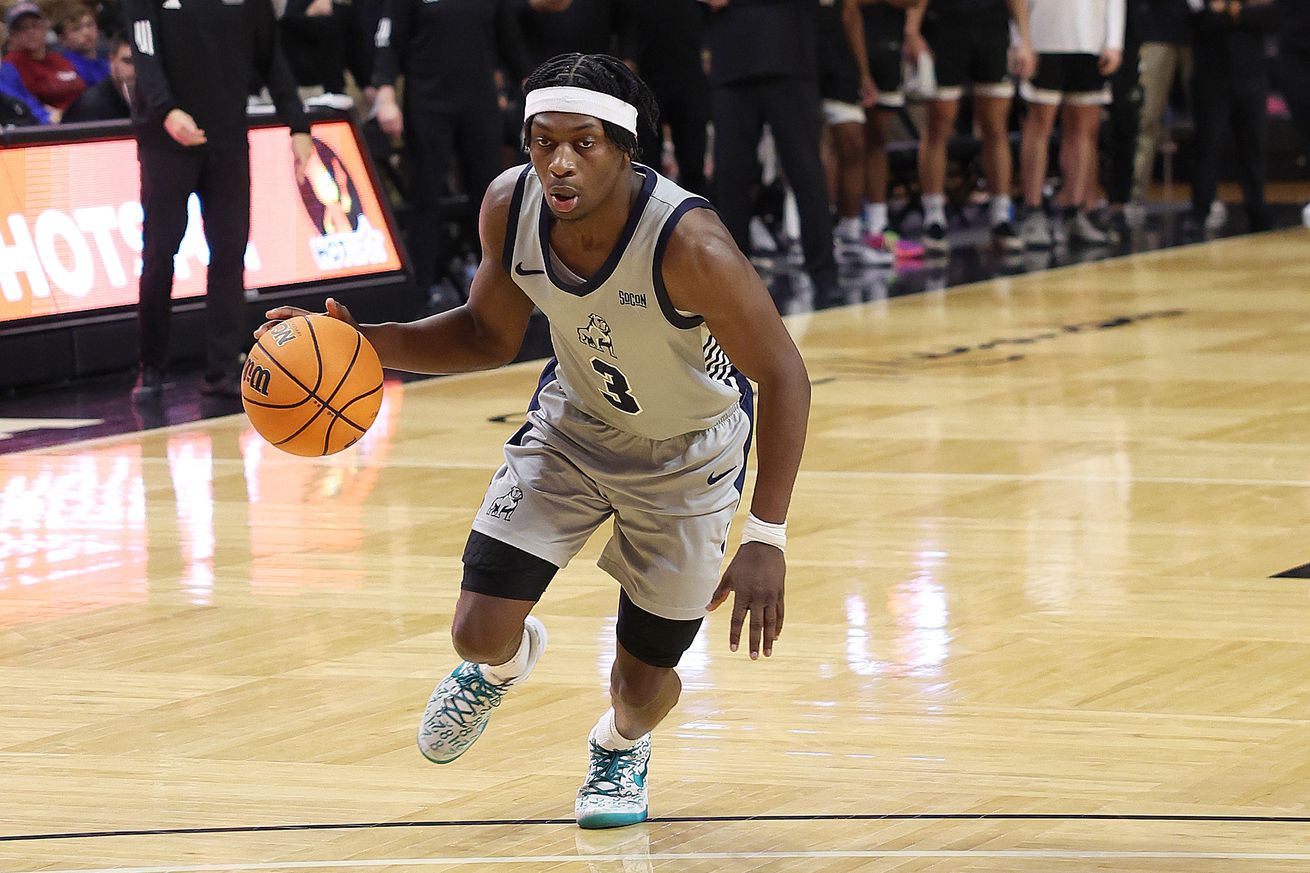
Comparing the incoming to the outgoing transfers
With yesterday’s announcement of Divine Ugochukwu transferring from Miami to Michigan State, the Spartans’ 2025-2026 basketball roster may be complete.
Xavier Booker (UCLA), Tre Holloman (North Carolina State), and Gehrig Normand (Santa Clara) have been replaced by Kaleb Glenn (Florida Atlantic), Trey Fort (Samford), and Ugochukwu.
Did the transfer portal produce a net gain or loss for MSU? Let’s see if we can find the answer, from a statistical perspective at least, with the help from some charts!
From an experience standpoint, the new Spartans compare favorably to those who have departed.
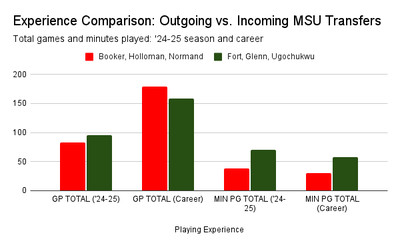
Combined, Booker, Holloman, and Normand have played in 179 games while Fort, Glenn, and Ugochukwu have seen action in 158. Last year, however, the new Spartans saw action in a combined 95 games compared to 83 for the players who transferred out.
Additionally, Fort, Glenn, and Ugochukwu combined for 70 minutes per game last season which is more than the 38 minutes the departing players have left behind. Over their careers so far, the incoming Spartans have played a combined average of 58 minutes per game compared to 31 for Booker, Holloman, and Normand.
Field goal shooting percentages also point to an advantage for the new Spartans over the old.
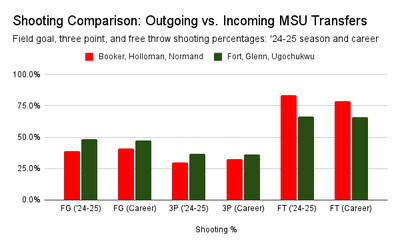
Last season, and over the course of their careers, Fort, Glenn, and Ugochukwu have produced better shooting percentages than the players who transferred out, including at the three-point level. The free throw line, however, is another story. Normand never attempted a free throw in his time at MSU but Booker and Holloman hit from a much higher rate from the stripe than the incoming transfers.
One quick note here – we used the total makes and attempts for each group of three players for the comparison. For example, Booker, Holloman, and Normand made 174 out of 450 field goal attempts last season – good for 38.7%. Fort, Glenn, and Ugochukwu went 378-781 (48.4%).
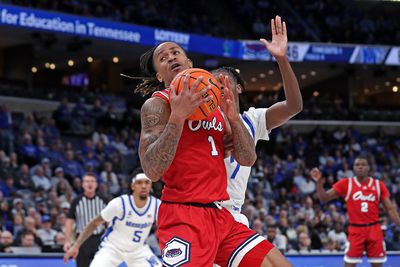
Photo by Justin Ford/Getty Images
Level of play may be an important consideration here though. Booker, Holloman, and Normand have accrued all of their experience so far at the power 4 conference level. Ugochukwu just finished his first year in college at P4 Miami, FL. Fort and Glenn, on the other hand, have spent time at both the P4 and mid-major levels.
Fort is particularly well-traveled. He started his career at mid-major Tennessee-Martin then spent a year in the SEC at Mississippi State before playing at Samford last year. Glenn started out at Louisville, leaving after one year to play last season at Florida Atlantic. So, each of the incoming transfers have spent a year at the P4 level.
Even when we compare only their experience on power conference teams with what the Spartans are losing, Fort, Glenn, and Ugochukwu still hold up reasonably well.
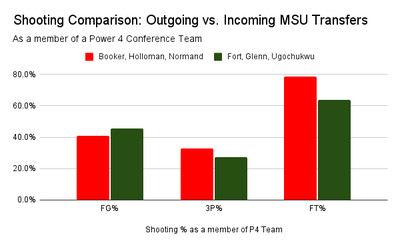
When looking only at their time on Power 4 teams (against presumably tougher competition), the new Spartans still shot it better overall than Booker, Holloman, and Normand have over the course of their careers. Three-point shooting may be a concern here though. It was a rough year beyond the arc for the Spartans last year and, in their combined careers, Booker, Holloman, and Normand have hit only 32.8% from deep. The new Spartans have struggled even more though – hitting just 27.4% of their three-point shots as members of power conference teams. However, this is influenced by Ugochukwu’s 17.6% (6-34) performance last season.
Fort, Glenn, and Ugochukwu definitely hold the edge when looking at points, rebounds, and assists, both last season and over the course of their careers.
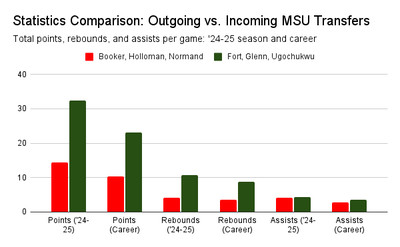
The comparison is still favorable for the new players when looking at what the Spartans are losing from the transfers from last year’s team to what Fort, Glenn, and Ugochukwu have done while on power conference teams.
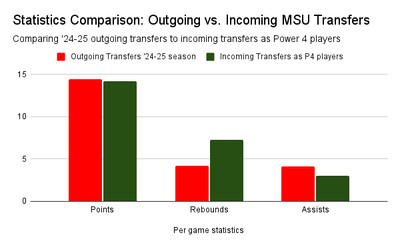
We can also look at a few more statistics that may not bode quite as well for the new Spartans and next year’s team. Fort, Glenn, and Ugochukwu have produced more steals than Booker, Holloman, and Normand but they’ve also turned it over more and are more prone to fouling.
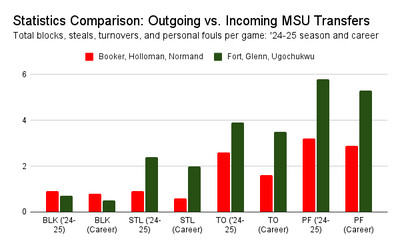
This still holds true when looking at what Booker, Holloman, and Normand produced last year compared to Fort, Glenn, and Ugochukwu’s power conference experience.
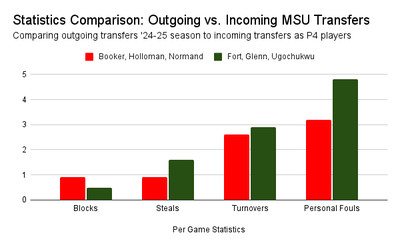
Finally, we can take a look at how Fort, Glenn, and Ugochukwu performed against higher-level competition last year. Interestingly, Fort and Glenn both faced the Spartans in Breslin as members of their former teams.
Fort played 22 minutes against MSU, going just 1-8 from the floor and scoring 4 points as Samford fell 83-75. At Arizona last year, Fort played 23 minutes in a 96-64 loss to the Wildcats. He scored 11 on 4-11 shooting, including 3-7 from three point range.
In an 86-69 loss to the Spartans, Glenn scored 6 for Florida Atlantic on 2-9 shooting. He only pulled down a single rebound in 23 minutes against MSU. In an 86-78 Owls win over Oklahoma State, Glenn played 27 minutes, producing 8 points and 4 boards. In two blowout losses to Memphis last season, Glenn combined for 55 minutes, 27 points, and 12 rebounds.
Miami endured a miserable season last year but Ugochukwu saw an increased role as it played out. He played 38 minutes in the Hurricanes’ 72-70 win over North Carolina State, totaling 6 points, 6 assists, and 3 rebounds. Ugochukwu’s season high in points was in Miami’s opener against Fairleigh Dickinson where he scored 15. In ACC play, he had a high of 10 points in a February loss to Louisville. In a 37 point loss to Duke in late February, Ugochukwu totaled 6 points, 10 rebounds, 3 steals, 2 assists, and 4 turnovers.
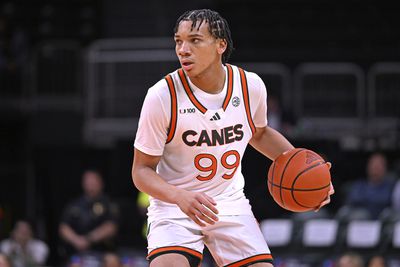
Photo by Samuel Lewis/Icon Sportswire via Getty Images
So, back to the original question – is all of this a net gain or loss for MSU? It looks like a gain. Ugochukwu meets the need for a backup point guard and he saw a lot of action as a freshman in the ACC. Fort can be a reliable three-point shooter and might be expected to start as MSU’s shooting guard. Glenn led FAU in scoring last season despite mostly coming off the bench. He may be expected to do so again at MSU to bolster the front court.
While Michigan State is hopefully emerging from the transfer circus in decent shape, the bigger questions may be what impact the freshmen can have and how big of a role will Jesse McCulloch play after his redshirt year. The Spartans regularly played three bigs last year and Szymon Zapala is gone. Hopefully McCulloch is ready to back up Jaxon Kohler and Carson Cooper.
Asking for a replacement to Jase Richardson’s contribution is a big ask but if at least one of the newcomers, Cam Ward or Jordan Scott, can make an impact then it could be a huge piece in MSU competing for another Big Ten Title.
